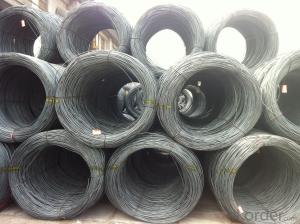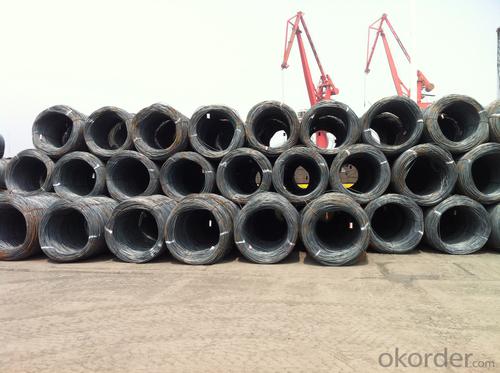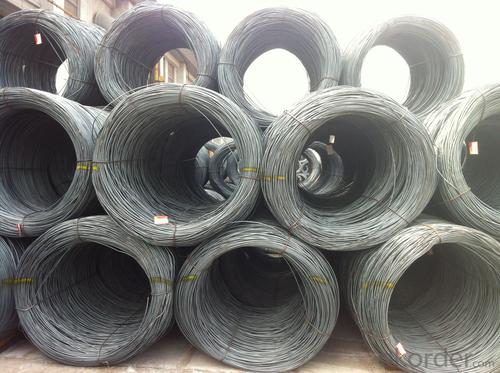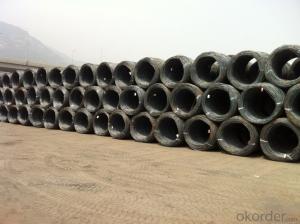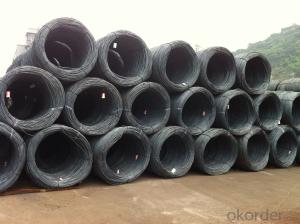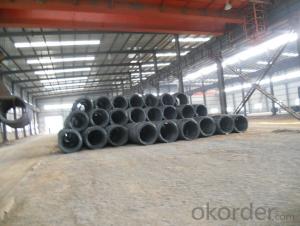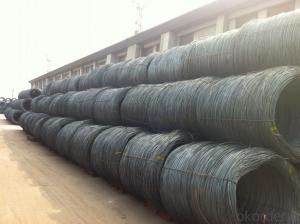Hot Rolled Steel Wire rods with Material Grade SAE1008
- Loading Port:
- Tianjin
- Payment Terms:
- TT OR LC
- Min Order Qty:
- 25 m.t
- Supply Capability:
- 50000 m.t/month
OKorder Service Pledge
OKorder Financial Service
You Might Also Like
OKorder is offering Carbon Steel Wire Rod at great prices with worldwide shipping. Our supplier is a world-class manufacturer of steel, with our products utilized the world over. OKorder annually supplies products to European, North American and Asian markets. We provide quotations within 24 hours of receiving an inquiry and guarantee competitive prices.
Product Applications:
Carbon Steel Wire Rod are ideal for structural applications and are widely used in the construction of buildings and bridges, and the manufacturing, petrochemical, and transportation industries.After hot-rolled the products shaped into coil and delivery as finished product, including round, square, rectangular, hexagonal and so on. Since most of the products are round, it is generally called wire rod. Carbon steel wire rod is widely used in construction and manufacturing. Carbon steel wire rod is mainly used for reinforcement of reinforced concrete and welded structure or reprocessed (roberts , nail, etc.) materials, especially used to produce wire drawing, welding electrode, nails, spring, electronic, precise machinery parts and so on.
Product Advantages:
OKorder's Carbon Steel Wire Rod are durable, strong, and resist corrosion.
Main Product Features:
· Premium quality
· Prompt delivery & seaworthy packing (30 days after receiving deposit)
· Corrosion resistance
· Can be recycled and reused
· Mill test certification
· Professional Service
· Competitive pricing
Product Specifications:
Chemical Composition:
Please kindly find our chemistry of our material based on SAE1006/SAE1008 as below for your information
Grade | Chemical Composition (%) | |||||
C | Mn | S | P | Si | B | |
SAE1006 | 0.03~O.07 | 0.32max | 0.045max | 0.040max | 0.30max | 0.0008min |
Mechanical properties | ||||||
Yield strength(N/mm2) | Tensile strength(N/mm2) | Elongation (%) | ||||
250-280 | 350-380 | ≥32 | ||||
Grade | Chemical Composition (%) | |||||
C | Mn | S | P | Si | B | |
SAE1008 | 0.10max | 0.3~0.50 | 0.050max | 0.040 max | 0.15max | 0.0008 min |
Mechanical properties | ||||||
Yield strength(N/mm2) | Tensile strength(N/mm2) | Elongation (%) | ||||
≥195 | 315-430 | ≥30 | ||||
FAQ:
Q1: How do you guarantee the quality of our products?
A1: We have established an advanced quality management system which conducts strict quality tests at every step, from raw materials to the final product. At the same time, we provide extensive follow-up service assurances as required.
Q2: What's your shipment type ?
A2: Usually we ship the goods by bulk vessel,if you want load them by container vessels,we can arrange as well .
Q3: How soon we can delivery the goods ?
A3: We have a mill with 20000mts of capacity per month. We can delivery the goods within one month.
Image:
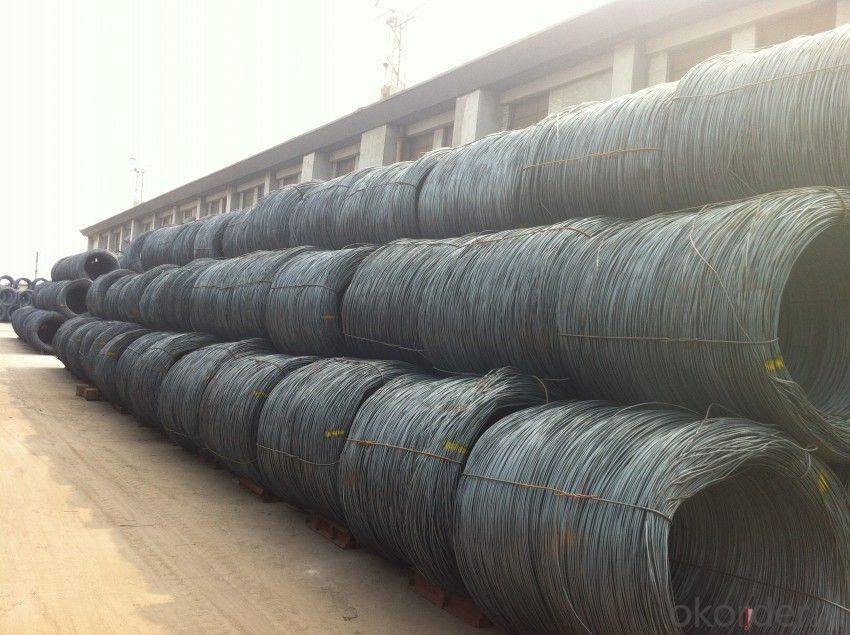
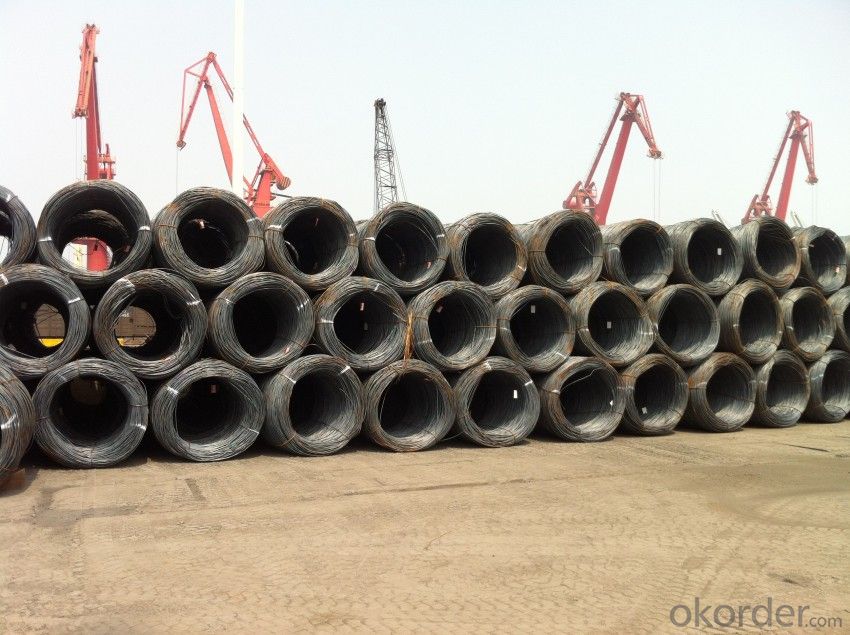
- Q: How is steel wire rod straightened and cut to length?
- The process of straightening and cutting steel wire rod, known as straightening and cutting, involves the use of a machine. This machine, referred to as a straightening machine, aids in the elimination of any bends or twists in the wire rod by feeding it through a series of rollers that exert pressure and gradually straighten it. Once the wire rod is straightened, it is then passed through a cutting machine that is specifically designed to cut through steel wire rods. This cutting machine is equipped with a blade or cutting tool and allows for the rod to be cut into the desired lengths. The length is determined by setting the desired length on the machine. The straightening and cutting process can be carried out either automatically or manually, depending on the scale of production. In automated systems, the wire rod is fed into the straightening and cutting machines through mechanisms such as conveyor belts. The desired length is set on a control panel, and the machines automatically straighten and cut the rod accordingly. For smaller scale operations, manual straightening and cutting are commonly employed. In this case, an operator manually feeds the wire rod into the straightening machine and then uses a cutting tool to manually cut it to the desired length. This process requires skill and precision to ensure accurate and precise straightening and cutting. Overall, the process of straightening and cutting steel wire rods is crucial in manufacturing precise lengths and straightness. It plays a vital role in industries such as construction, automotive, and manufacturing, where steel wire rods are utilized in various applications.
- Q: How is steel wire rod used in the production of ropes?
- Steel wire rod is used in the production of ropes as the main material for the rope's core. It provides strength and durability, allowing the rope to withstand heavy loads and harsh conditions. The steel wire rod is typically twisted or braided together to form the core, which is then covered with a protective outer layer to enhance flexibility and improve grip. This combination of strength and flexibility makes steel wire rod essential in creating ropes that are widely used in various industries like construction, transportation, and maritime.
- Q: What are the common production processes for boron-coated steel wire rod?
- The common production processes for boron-coated steel wire rod include wire drawing, heat treatment, boron coating, and final inspection.
- Q: What are the main factors affecting the market expansion of steel wire rod?
- The main factors affecting the market expansion of steel wire rod include economic growth and industrial development, infrastructure investments, demand from various end-use industries such as automotive, construction, and manufacturing, availability and cost of raw materials, technological advancements in production processes, government policies and regulations, international trade dynamics, and competition from alternative materials.
- Q: How is steel wire rod used in the production of wire mesh conveyor belts?
- Steel wire rod is a crucial component in the production of wire mesh conveyor belts as it serves as the primary material for manufacturing the wire mesh. The wire rod is drawn through a series of dies to reduce its diameter and increase its length, resulting in a long and thin wire. This wire is then woven or welded together to create the mesh pattern of the conveyor belt, providing strength, durability, and flexibility for conveying various materials.
- Q: How is steel wire rod used in the manufacturing of automotive suspension springs?
- Steel wire rod is used in the manufacturing of automotive suspension springs as it provides the necessary strength and durability required to support the weight of the vehicle and provide a smooth and stable ride. The steel wire rod is shaped and coiled to form the spring, and its high tensile strength ensures that it can withstand the constant compression and extension forces experienced during driving. Additionally, the flexibility of the steel wire rod allows the suspension spring to absorb shocks and vibrations from the road, improving overall vehicle stability and comfort.
- Q: How does the steel wire rod market vary regionally?
- The steel wire rod market varies regionally based on factors such as local demand, production capacity, and infrastructure. Different regions have distinct market dynamics and growth drivers. For example, regions with rapidly expanding construction and manufacturing sectors may experience higher demand for steel wire rods. Additionally, regional differences in raw material availability, labor costs, and government policies also contribute to variations in the steel wire rod market.
- Q: How does the quality of steel wire rod affect the performance of wire products?
- The quality of steel wire rod significantly affects the performance of wire products. High-quality wire rod ensures superior strength, durability, and resistance to corrosion, which are crucial for wire products to function optimally. Inferior quality wire rod may result in weakened wire products that are more prone to breakage, reduced conductivity, and lower overall performance. Therefore, using high-quality steel wire rod is essential to produce reliable and high-performing wire products.
- Q: What are the common production processes for protactinium-coated steel wire rod?
- The common production processes for protactinium-coated steel wire rod typically involve several steps. First, the steel wire rod is thoroughly cleaned and prepared to ensure its surface is free of any contaminants. Then, a layer of protactinium is applied to the steel wire rod using a specialized coating technique such as electroplating or chemical vapor deposition. This process ensures a uniform and durable coating of protactinium on the wire rod. Finally, the coated wire rod is carefully inspected and tested for quality control before it can be used in various applications.
- Q: How are steel wire rods used in the manufacturing of fasteners?
- Steel wire rods are an essential component in the manufacturing of fasteners. Fasteners, such as bolts, screws, and nails, are used to join or secure two or more objects together. Steel wire rods serve as the raw material for fasteners, providing the necessary strength and durability. The manufacturing process begins with steel wire rods, which are usually made from carbon or alloy steel. These rods are typically produced through a hot rolling process, where the steel is heated and then passed through a series of rollers to achieve the desired shape and size. The resulting wire rods are then further processed to meet the specific requirements of fastener production. One of the primary uses of steel wire rods in fastener manufacturing is for the production of bolts and screws. The wire rods are typically cut into specific lengths and then undergo a series of operations, such as heading, threading, and heat treatment. Heading involves forming the head of the bolt or screw, while threading creates the ridges or grooves that allow them to be screwed into place. Heat treatment is often employed to enhance the strength and hardness of the fastener. Steel wire rods are also used in the production of nails. The rods are first drawn to the desired diameter and then cut into appropriate lengths. The ends of the wire are sharpened, and the nails are formed by a process called pointing. Pointing involves creating a sharp tip on one end of the wire, which allows the nail to penetrate materials easily. In addition to bolts, screws, and nails, steel wire rods are used in the manufacturing of other fasteners, such as rivets, cotter pins, and clips. These fasteners are essential in various industries, including construction, automotive, aerospace, and furniture. Overall, steel wire rods play a crucial role in the manufacturing of fasteners by providing the necessary strength, durability, and versatility required for joining and securing objects together. They serve as the foundation for the production of various fastener types, enabling the construction of strong and reliable structures.
Send your message to us
Hot Rolled Steel Wire rods with Material Grade SAE1008
- Loading Port:
- Tianjin
- Payment Terms:
- TT OR LC
- Min Order Qty:
- 25 m.t
- Supply Capability:
- 50000 m.t/month
OKorder Service Pledge
OKorder Financial Service
Similar products
Hot products
Hot Searches
Related keywords

